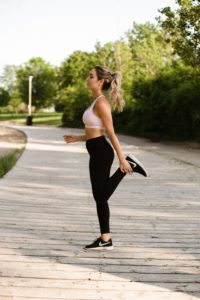 There are many motivations for us to exercise. It may be to improve our physical strength or fitness, maintain a healthy lifestyle to reap the health benefits, or to lose weight – just to name a few. Whatever your reason for exercise, completing the right kind of exercise can look very different to different people. There is no one size fits all – which is great news! It means you can choose the best, most enjoyable and importantly the most sustainable exercise for you.
There are many motivations for us to exercise. It may be to improve our physical strength or fitness, maintain a healthy lifestyle to reap the health benefits, or to lose weight – just to name a few. Whatever your reason for exercise, completing the right kind of exercise can look very different to different people. There is no one size fits all – which is great news! It means you can choose the best, most enjoyable and importantly the most sustainable exercise for you.
To promote Exercise Right Week this week, we’ve put together 9 tips to help you choose the right exercise for you.
1. What makes you feel good when you move?
Start by choosing exercise that makes you feel good. Exercise should not cause your joints to ache or flare-up old injuries! Understand your limitations when choosing your physical activities.
Choose activities that make you feel good when you move.
2. What activities do you enjoy?
You’re more likely to continue to regularly perform activities that you enjoy. If you hate running, you don’t need to become a runner to add regular exercise into your routine. Think about the activities that you really enjoy – boxing, pilates, tai chi, dancing, tennis, cycling or even walking the dog – and note these down. Start by incorporating these specific activities into your routine so you can look forward to them while your new habits start to form.
3. What classes are available locally?
If you’re unsure about what activities you’ll enjoy, look at what group classes are available in your local area. Research has found that working out in a group decreases perceived stress, while increasing a person’s physical, mental, and emotional quality of life, compared with exercising regularly on one’s own or not engaging in regular exercise [1].
4. What are your all-weather options?
We can’t control the weather and, as we head into the cooler months, rain can make exercising outdoors unpleasant. Make sure you have both outdoor and wet weather exercise options on the cards. Not only is it more mentally challenging to return to exercise after an unexpected break, but research has shown that even elite sports players will start to lose strength after only three weeks of having a break from training [2].
5. Consistency doesn’t mean every day
Don’t set unrealistic expectations for yourself that may leave you feeling disappointed or demotivated from being unable to manage daily exercise goals. The Australian Exercise Guidelines recommend approximately 2.5 to 5 hours of moderate physical activity every week, or alternatively 75 minutes to 2.5 hours of vigorous physical activity every week. This means that one hour, 3-4 times per week of moderate activity is sufficient to bring you in line with the recommendations.
6. Slow and steady wins the race
Do you know one of the most common causes of exercise-related pain and injury that we see here at My FootDr? Those that go too hard and too fast, overusing and straining their muscles that aren’t used to that exercise intensity.
Start slowly, don’t expect to run for an hour or 10kms on your first run. Listen to your body – if something feels painful or uncomfortable, slow down. Gradually build up your pace and intensity. Don’t push yourself before you are ready. Starting slow and steady will not only make the exercise more enjoyable – but help prevent injury, too.
7. Prepare your body
Warming your body up, stretching, cooling down, and having enough water are all keys to helping your body successfully get through each exercise, without leaving you feeling too sore for the days to come. If you’re unsure about the best ways to warm-up, cool-down or stretch, talk to our team.
8. Be comfortable
Wear comfortable clothes during exercise that support your body and aren’t too tight. If you’re prone to blisters on your feet, try absorbent socks that wick moisture away from your feet, as opposed to leaving them damp and promoting irritation. Check your shoes – are they worn down or are they doing a good job of supporting your feet, arches and ankles?
Shoe recommendations and prescriptions are one of our specialities here at My FootDr as we know how good it feels to have shoes that perfectly match your foot type – and the difference it can make to your exercise routine. Many of our clinics have on-site retail clinics for footwear – and specially trained staff to ensure you get the right fit at no extra charge.
9. Treat any problems that develop
Our final and potentially most important piece of advice is to pay attention to any niggles, aches and pains that develop during your exercise journey. Prevention and early treatment is the key to ensuring a safe and optimal recovery.
If you’re worried about a pain you’re experiencing, have a problem with your lower limbs, or want to safely and effectively develop healthy exercise habits and get started on the right foot, book in with your My FootDr podiatrist. Book your appointment online here or call us on 1800 FOOT DR.


